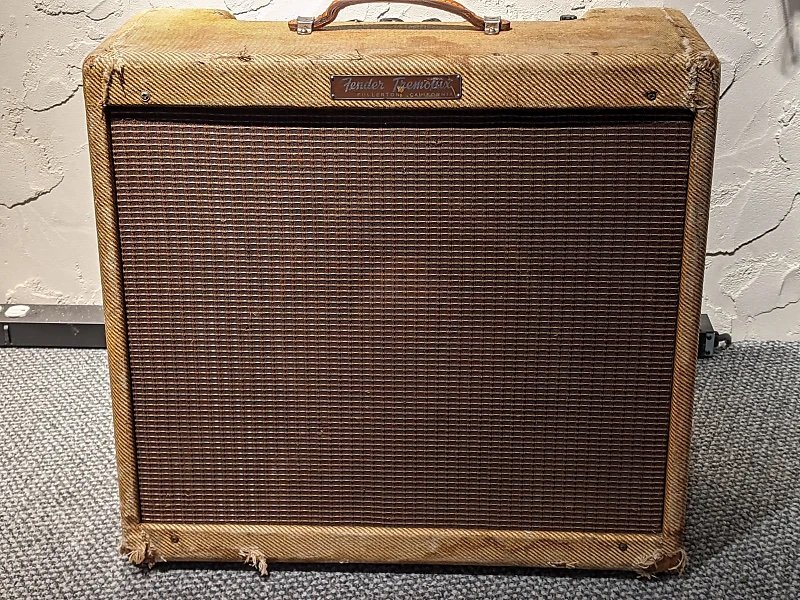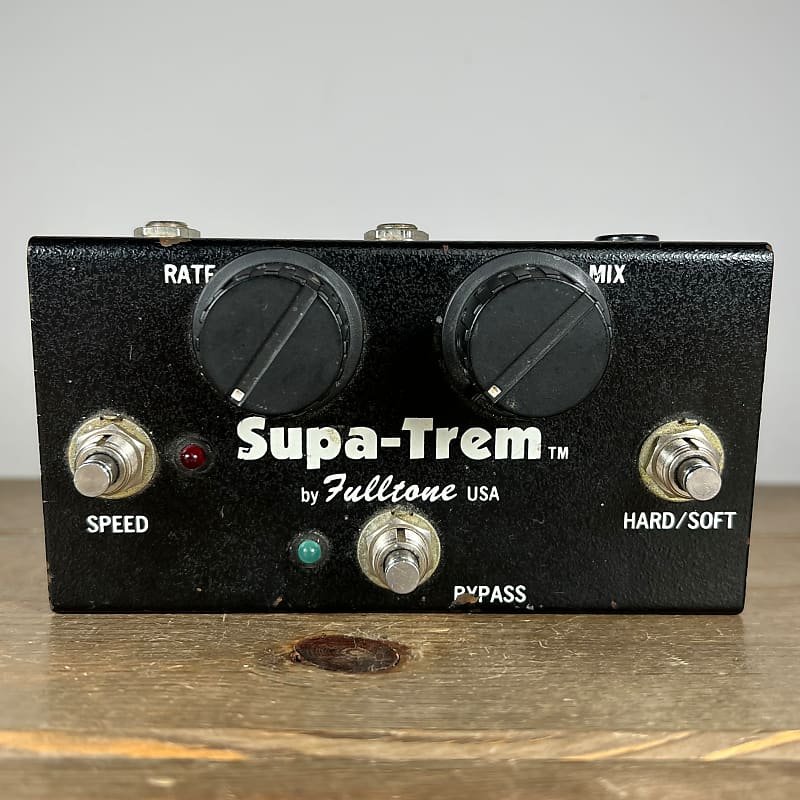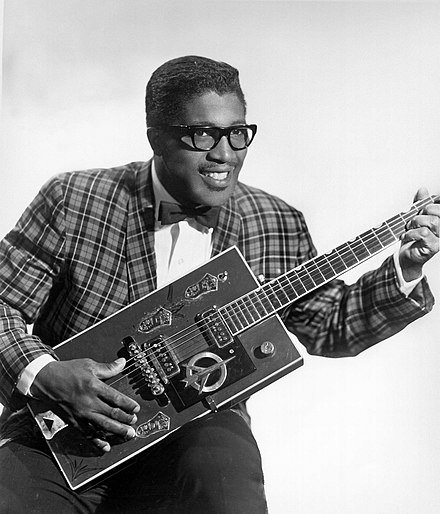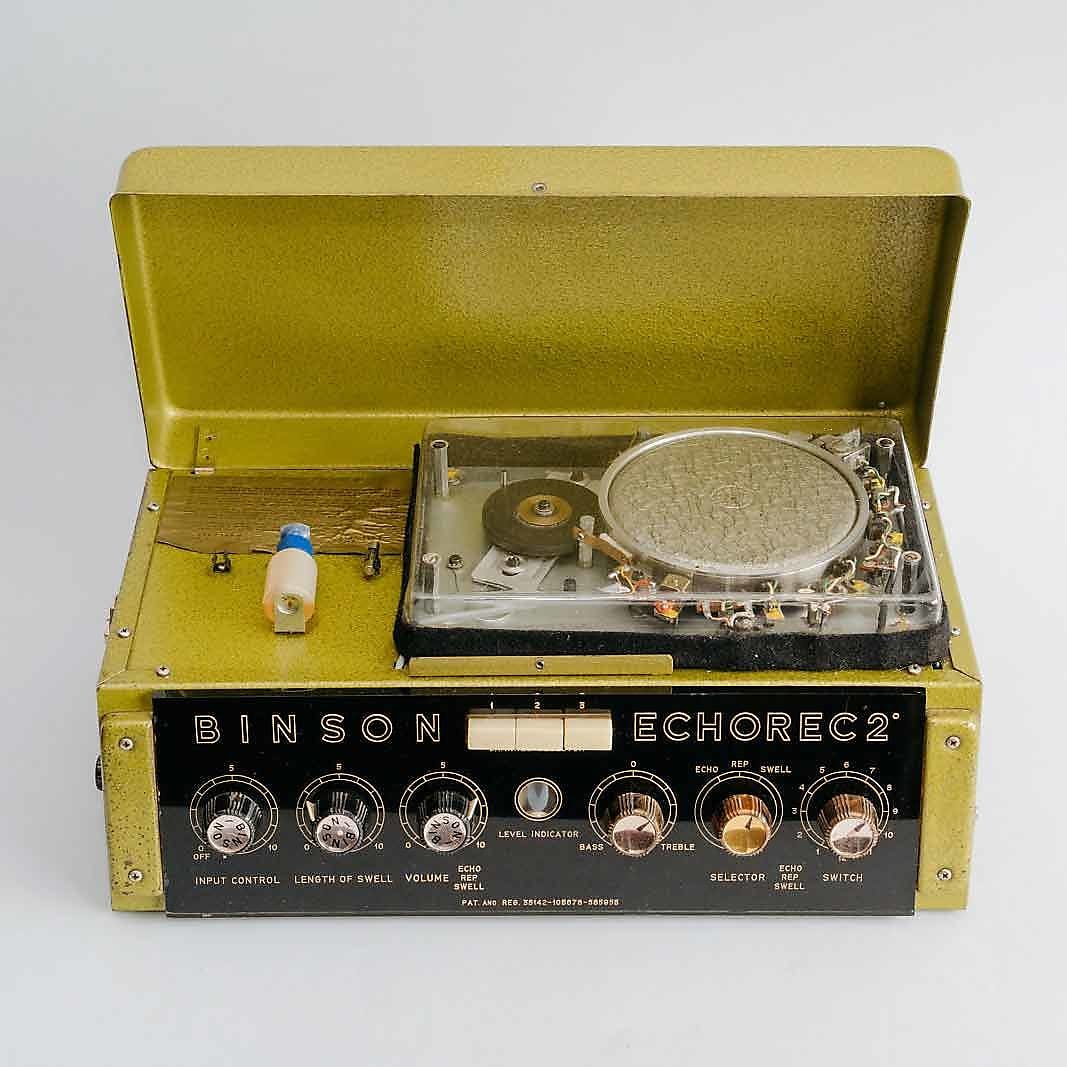Effectrode Delta-Trem
I have investigated, purchased, and sold many reverb and tremolo pedals. Unfortunately, tracking down what was missing for me in these effects took time. For many years the options were limited, and what I wanted in reverb or tremolo didn't exist in pedal format.
In the past several years, some of my most significant tone gaps have been filled. So we're living in a noteworthy era for guitar tone.
Designers have been putting a lot of thought into the future and past of guitar tones.
One of my biggest complaints for many years was with pedal format tremolo pedals. Sadly, a lot of amps don't have built-in tremolo, including my Victoria 35115 Tweed.
Victoria 35115
I find myself wanting tremolo with the sound of the Tweed 35115, which leads me to pedals.
Tremolo was created in pedal-like format by a company called DeArmond in the 1940s. It's the sound of Bo Diddley and Duane Eddy, to name a few.
1955 Fender Tremolux
In the 1950s, companies such as Fender started installing tremolo in their amps, using tubes. Changing the bias of the tube creates volume fluctuations. (This is different from the DeArmond design, which is unique). But of course this is an oversimplification of tube tremolo. I want to focus on the tone of tremolo in this article. If you’d like to know more about the mechanics of tremolo, read this insightful article from Phil Taylor. You can read about the history of tremolo on Premier Guitar.
One issue I’ve had with tremolo pedals over the years is that they seem to have focused purely on LFO (low frequency oscillation) modulation of volume.
Color and saturation from tubes and circuitry wasn’t considered at all. For a while, the trend was to have as little color in the tone as possible. Thankfully, that trend is fading out. I think the word "clean" as applied to guitar tone has been abused over the years. The clean sounds on old records still has a lot of color and saturation.
The saturation and color of a tremolo circuit in a tube amp are just as important to me as the modulating volume effect.
I’ve never believed it’s good enough just to get by. Even on gigs that don’t warrant a huge investment in time and detail, I can't help wanting the best tone I can get. That’s why you might have found me lugging a real tape echo to a 7:00 PM slot on a Wednesday night Rockwood Music Hall gig years ago.
Because the nuance of tone is crucial to me, you could understand why I was unsatisfied with many pedal tremolos.
Beginnings
My first tremolo pedal was the Boss tremolo pedal. Unfortunately, I was confused by the tone when I got it. I was too young and inexperienced to know why it didn't sound good. I sent the pedal back within days. The tremolo was unsatisfying, and later, I realized I loath the sound of Boss buffers. (Not all buffers sound bad!)
Later, I tried many other tremolo pedals, including the Walrus Monument. The Monument isn't a bad-sounding tremolo and is made well. It's perfect if you want a non-colored tremolo. But it wasn't the classic tremolo sound I wanted.
I also used the Fulltone Supa-Trem—a great-sounding tremolo that reminds me more of the blackface Fender tremolo. The Supa-Trem is very reliable and is my fave non-tube tremolo. The Supa-Trem has an actual photocell, so while it's not a tube tremolo, it has an authentic tremolo sound.
Still, I longed for a more tube-sounding tremolo. A tremolo that not only allowed for more variety in wave shapes that capture the tremolos of various old amps, but that also had the natural saturation you get from tube gear.
And there it is: Tubes are the special ingredient that can't be produced by a non-tube circuit. Analog gear often has some saturation. Tape, tubes, and mixing consoles all add color to your signal. This color is highly sought after in studios and many plugins attempt to emulation it.
It was no different inside an amp. Both reverb and tremolo on old amps used tubes. Your guitar signal went through two other stages of tubes, which added saturation and coloration to your signal.
Most pedal tremolos sound sterile to me because my ears miss the saturation in tube circuits. If only someone would figure out how to make a tube tremolo in a pedal.
Revelations
Well, the Effectrode Delta-Trem has done it. Phil Taylor has designed a tube tremolo in a pedal that runs at plate voltage, allowing more headroom. And guess what's also there? That lovely tube saturation and color.
Saturation
I want to clarify that the Delta-Trem’s saturation is not heavy. We're not talking saturation to the point of audible overdrive. We're talking saturation that adds warmth and harmonic complexity to your sound.
If you want more growl, you can swap out the stock 12AU7 tubes for a 12AX7 or 12AY7. This will induce more "overdrive" into the circuit.
Shapes of Things
On top of this lovely natural color and saturation, the Effectrode Delta-Trem has other great options.
Bo Diddley who popularized the DeArmond Tremolo and tremolo sound
Phil has built in three banks of tremolo styles: filament, fluid, and neon. Within these banks, there is also a selection of LFO waveforms that emulate various tremolo circuits.
Fender and Vox amps used tube tremolo in their circuits at one point, but each had a slight twist in the waveform. By selecting the filament bank using the toggle switch on the back of the Delta-Trem, you can choose the waveform used in Vox amps or early Fender amps.
Fluid is the sound of the DeArmond tremolo, and neon is the sound of the photocell tremolo.
As you move through these banks and waveshape options, you’ll notice, for example, that the neon bank allows for more choppy tremolo. And that the filament bank is gentler, just like tube bias tremolo.
DeArmond Tremolo: The first tremolo
Let's look at the features listed on the Effectrode site:
FEATURES
Genuine Tube Circuitry: A 100% vacuum tube and 'Raysistor' audio circuitry generates the tremolo effect. The tubes operate at real amp plate voltages at 300V, just like in a vintage tube amp!
Smooth and Deep Tremolo: LFO with advanced pulse shaping capability that can accurately replicate either smooth “bias” or more intense, choppy “photocell” tremolo effects.
True S-T-E-R-E-O: When linked, the signal ping-pongs between left and right outputs, or the two tremolos can be split for independent operation, where left and right channels drift in and out of phase.
'Dakaware' Knobs: Authentic bakelite 'Dakaware' Chicago 1510 knobs, custom manufactured in the USA for Effectrode using the original 1940s moulds.
Turquoise LEDs pulsate with modulation speed for visual song tempo matching.
Includes a high-quality low-noise switched mode 12VDC at 1.5A wall wart-compatible. Accepts 100V to 240VAC mains input and comes with different mains outlet adaptor plugs, so there is always a plug that fits the country you are playing in.
Boost Me Up
One trick you can do with the Delta Trem is to turn the depth knob completely down and use the circuit as a boost. In addition, you can set the amount of boost inside the pedal. This is a welcome feature as you can lose volume when turning on the tremolo. The boost is included to compensate for the signal loss but can also be an incredible boost/preamp to the front end of your amps.
Sometimes on gigs I reach down and turn the tremolo depth down instead of bypassing the pedal, as I like how it hits the front end of the amp.
These days, people often add effect pedals to their chains and get the desired effect. But you rarely hear people talk about how these effects improve their tone.
There was magic in old gear, whether an old tube Echoplex, Binson Echorec, Pultec EQ, Fairchild limiter, etc. The tone was so good that players and engineers often used the devices with the effects turned off so they could just run through the circuitry as a preamp.
I've been on many sessions where mix engineers placed a Pultec EQ on the mix bus but didn't adjust any parameters. The Pultec circuitry adds a unique tone by itself.
It's details like this that Phil understands and makes present in every one of his pedals. So you're not just getting a tremolo. You're getting a tone enhancer.
Tap Tempo
One issue with analog tube tremolo is syncing the tremolo in time. I've spent plenty of time at the tremolo controls on a tube amp trying to sync the tremolo in time. There are times when out-of-sync tremolo works great. You don't always have to sync the tremolo. But there are moments where it must be in sync. The added feature of being able to sync a tube tremolo is most excellent.
When in tap mode, you can use the speed knob to divide or multiply the tremolo rate from quarter notes to 16th notes.
Rhythm Feature
Phil added an exciting feature on the Delta-Trem that can alter the rhythm of the tremolo. There are eight options to gradually increase the complexity of the rhythm.
I dug into the rhythm feature with heavily saturated sounds. A fuzzed-out baritone or a synth pad shined in this mode, and the long sustain brought out the rhythms.
Stereo
The Delta-Trem is designed to give options for many tremolos uses. Phil thought of many possible scenarios, including stereo tremolo.
Stereo tremolo is not just great for guitarists that use stereo rigs but also for keyboardists and recording engineers/mixers.
I consider the Delta-Trem a studio tool as much as a guitar pedal. It can be a fantastic tool for sound design and film composition.
There are a couple of options regarding stereo.
1: Stereo panner/splitter for mono sources. Let's say I want to split my mono guitar or mono Prophet-10 synth into two different effect chains to create a weird, disorienting sound.
Let's say output one will be a large reverb on the Chase Bliss CXM-1978, and output two will go to the Effectrode Mercury Fuzz set to high gain, destroying the signal.
The Delta-Trem will pan the tremolo left and right, giving you this contrasting effect of dry aggressive sound and long-distance alternating. You could then pan them hard left in the mix or treat them as a mono source.
You can get creative with your signal chains, and by playing with the rhythm and speed knobs you can get pretty innovative with special effect sounds. I love experimenting and creating sound worlds in the studio when composing for film and TV.
You can also do true stereo tremolo by sending a stereo source in and adjusting each channel's shape, depth, and speed. But can a tube pedal also take a true stereo signal and process the left and right channels independently? Yes, yes, it can!
Imagine sending a collection of guitar or synth pads to a stereo bus in your DAW, then sending that stereo bus out to the Delta-Trem.
This is exciting news for mixing and working with ambient soundscapes. Just think of how creative you can get using the rhythm knob and speed knob variations on the left vs. right channels!
Let's listen to some examples I recorded.
All examples recorded through:
Ampete 88S amp switcher, Universal Audio OX, API 312 preamp, Purple Audio MC77, Universal Audio Apollo
EX1: 1964 Guild Starfire, Victoria 35115, Analog Man ARDX20 Dual, Surfybear Metal, Effectrode Delta-Trem
EX2: Fender ‘52 Reissue Telecaster with Voodoo pickups, Analog Man ARDX20 Dual, Effectrode Delta-Trem
EX3: Gibson Les Paul Standard with Voodoo ‘59 pickups, Marshall SV20H, Analog Man ARDX20 Dual, Effectrode Delta-Trem. The Delta-Trem is also boosting the front end of the Marshall for more gain and depth.
EX4: Dan Electro '59 M with Gemini Lipstick pickups, Vox AC15, Surfybear Metal, Effectrode Delta-Trem
EX5: Sequential Circuits Prophet-10, Dave Smith OB-6, Effectrode Delta-Trem in stereo panning mode. For the synth examples I ran mono out from both synths into the Delta-Trem using a TRS-to-TS cable. The Delta-Trem is panning between the two synths, which can create cool contrasting effects.
EX6: Sequential Circuits Prophet-10, Dave Smith OB-6, Surfybear Metal, Effectrode Delta-Trem in stereo panning mode
EX7: Sequential Circuits Prophet-10, Dave Smith OB-6, Hydrasynth generated arpeggio, Effectrode Delta-Trem in stereo panning mode
EX8: Sequential Circuits Prophet-10, Dave Smith OB-6, Chase Bliss CXM 1978, Effectrode Delta-Trem in stereo panning mode. You can hear the rhythm knob engaged on this, creating interesting panning patterns.
EX9: Mellotron M4000D Mini with nylon string patch, Analog Man ARDX20 Duo, Effectrode Delta-Trem
EX10: Mellotron M4000D Mini with celeste patch, Analog Man ARDX20 Duo, Effectrode Delta-Trem















